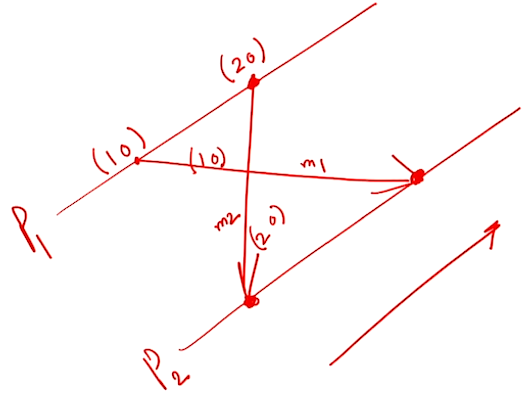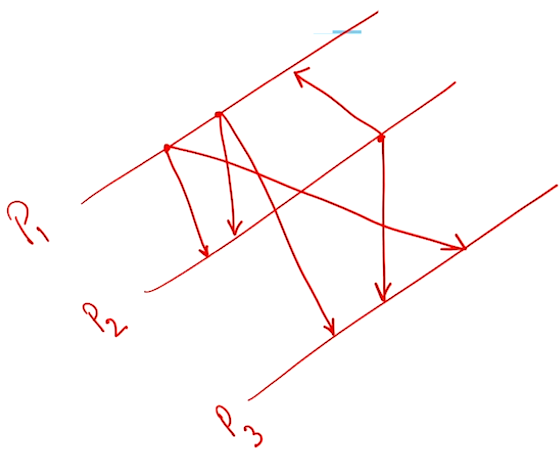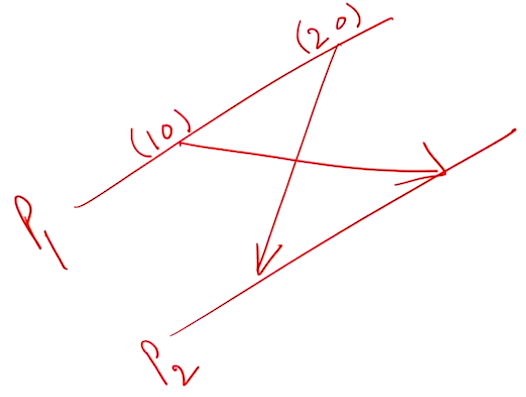Module 4#
Birman Schiper Stephenson BSS Protocol#
- This algorithm works with broadcasting messages
- Before broadcasting \(m\), process \(P_i\) increments vector time \(VT_{pi}[i]\) and timestamps \(m\)
- Other processes receives this \(VT_m\) from \(P_i\)
- The process delays the receive till the following two conditions are met:
- \(VT_{Pj}[i] = VT_m[i] - 1\), this means \(P_j\) received all other messages from \(P_i\)
- \(VT_{Pj}[k] >= VT_m[k]\) for every \(k \in \{1, 2, ... n\} = \{i\}\), meaning \(P_j\) received all messages also received by \(P_i\) before sending message \(m\).
- When \(P_j\) delivers \(m\), \(VT_{Pj}\) updated by IR2 of Vector clock
Example 1#

- \(P_2\) receives \(m_2\) first with a \(VT = (2, 0)\)
- At \(P_2\) the \(VT = (0, 0)\) and \((0, 0) \ne (2, 0) - (1, 0)\)
- Since this rule is not satisfied, \(m_2\) is kept in queue
- \(P_2\) receives \(m_1\) now with a \(VT = (1, 0)\)
- At \(P_2\) the \(VT\) is still \((0, 0)\), and the first condition check satisfies since \((0, 0) = (1, 0) - (1, 0)\)
- Also second rule is satisfied as well.
- Since the rule is satisfied, \(m_1\) is received, and \(VT_2\) is updated to \((1, 0)\)
- \(P_2\) now checks condition for the message \(m_2\) in queue. Now since the \(VT\) at \(P_2\) is \((1, 0)\), the two rules are satisfied, and the message \(m_2\) is now received. and the \(VT\) is updated to \(max(VT_2, VT_1) = (2, 0)\)
Example 2#

- \(P_1\) sends message to \(P_2\) and \(P_3\) with \(VT_1 = (1, 0, 0)\)
- \(P_2\) has \(VT_2 = (0, 0, 0)\)
- \(P_2\) receives message from \(P_1\)
- \(VT_1 = (1, 0, 0)\) satisfies the first condition
- It also satisfies the second condition
- This message is received by \(P_2\) and \(VT_2 = (1, 0, 0)\)
- \(P_2\) receives another message from \(P_1\)
- \(VT_1 = (2, 0, 0)\) satisfies the first condition
- It also satisfies the second condition
- This message is received by \(P_2\) and \(VT_2 = (2, 0, 0)\)
- \(P_3\) has \(VT_3 = (0, 0, 0)\)
- \(P_3\) receives message from \(P_1\)
- \(VT_1 = (2, 0, 0)\) does not satisfy the first condition
- This message \(m_{2P1}\) is kept in queue
- \(VT_3 = (0, 0, 0)\)
- \(P_3\) receives message from \(P_2\)
- \(VT_1 = (2, 1, 0)\) satisfies the first condition
- But it does not satisfy the second one because the 2 messages from \(i\) are not yet received
- This message \(m_{1P2}\) is kept in queue
- \(VT_3 = (0, 0, 0)\)
- \(P_3\) receives message from \(P_1\)
- \(VT_1 = (1, 0, 0)\) satisfies the first condition
- It also satisfies the second condition
- Since both are satisfied, \(VT_3 = (1, 0, 0)\)
- Since \(VT_3\) is \((1, 0, 0)\)
- The message \(m_{2P1}\) with \(VT_1 = (2, 0, 0)\), satisfies the first condition and the second condition
- Now this message is marked received and updates the \(VT_3\) to \((2, 0, 0)\)
- Since \(VT_3\) is \((2 0, 0)\)
- The message \(m_{1P2}\) with \(VT_2 = (2, 1, 0)\), satisfies the first condition and the second condition
- Now this message is marked received and updates the \(VT_3\) to \((2, 1, 0)\)
- \(P_1\) has \(VT_1 = (2, 0, 0)\)
- \(P_1\) receives message from \(P_2\)
- This message has \(VT_2 = (2, 1, 0)\)
- This VT satisfies the first condition
- This VT also satisfies the second one as well
- This message is marked as received and \(VT_1\) is updated to \((2, 1, 0)\)
Schiper-Eggli-Sandoz SES protocol#
- There is no need for broadcast messages
- Each process maintains a vector \(V_P\) of size \(N - 1\), \(N\) being the number of processes in the system
- \(V_P\) is a vector of tuple \((P' , t)\): \(P'\) is the destination process id and \(t\) is the vector timestamp
- \(T_m\): logical time of sending message \(m\)
- \(T_{Pi}\): present logical time at \(P_i\)
- Initially \(V_P\) is empty

Example 1#

- \(P_1\) sends \(m_1\) with \((1, 0)\{\}\) to \(P_2\)
- \(VP_1 = \{(P_2, 10)\}\)
- \(P_1\) sends \(m_2\) with \((2, 0)\{(P_2, 10)\}\) to \(P_2\)
- \(VP_1 = \{(P_2, 20)\}\)
- \(P_2\) receives message \(m_2\) from \(P_1\) containing \((2, 0)\{(P_2, 10)\}\)
- Since \(VP_1\) has a tuple for \(P_2\), and since the clock value is greater than the local clock, the message is buffered
- \(P_2\) receives message \(m_1\) from \(P_1\) containing \((1, 0)\{\}\)
- Since the \(VP_1\) does not have a tuple for \(P_2\) the message is received
- And after receiving we apply IR2 to get \(T_2\) to be \((1, 0)\) and then apply IR1 to get \((1, 1)\)
- The buffered message is now considered for receiving
- Since the tuple has \(t_m = (1, 0)\), the \(T_2\) becomes \((2, 1)\) after IR2 and then \((2, 2)\) after IR1
Example 2#

- \(P_1\) sends \(m_{13}\) with \((1, 0, 0)\{\}\)
- \(P_1\) sends \(m_{12}\) with \((2, 0, 0)\{(P_3, 100)\}\)
- \(P_2\) receives message from \(P_1\), since the vector does not have an entry for P_2 the message is delivered and the local clock becomes \(max(000, 200) + 010 = 200 + 010 = 210\) and \(VP_2\) now has \(\{(P_3, 100)\}\)
- \(P_2\) sends a message to \(P_3\) with \((2, 2, 0)\{(P_3, 100)\}\) data
- \(P_3\) receives message from \(P_2\)
- since the vector has entry for \(P_3\) and the clock is higher than local clock it is buffered
- \(P_3\) receives message from \(P_1\)
- Since vector is empty the message is received
- The local clock of \(P_3\) becomes \(max(000, 100) + 001 = 101\)
- \(P_3\) receives buffered message
- Since 101 is greater than 100 the message is received
- Now the local time becomes \(max(101, 220) + 001 = 222\)
